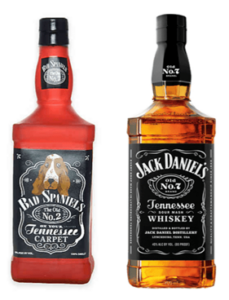Last week, in a unanimous opinion, the Supreme Court reversed and vacated the lower court's rulings in favor of Bad Spaniels. While this latest decision is a “win” for Jack Daniel’s, the allegedly infringing Bad Spaniels dog toy remains on the market pending remand of the case for further proceedings.
Jack Daniel’s filed an action against dog toy company VIP Products, LLC, for a chew toy designed to mimic the Jack Daniel’s whiskey bottle bearing the label Bad Spaniels and other notations. A comparison of the two products at issue and an overview of the trademark infringement and dilution claims Jack Daniel’s brought against Bad Spaniels can be found in my colleague Jeanne Hamburg’s previous article on the case here. As a reminder, the two products are displayed below:

From Supreme Court of the United States
Broadly, the Supreme Court did not agree with the legal standards and tests used by the lower courts to analyze Jack Daniel’s claims for trademark infringement and dilution by tarnishment. While Justice Kagan characterized the opinion as “narrow,” the Supreme Court’s adjudication of these issues sheds light on how federal courts should analyze trademark infringement and dilution claims that touch on First Amendment considerations like parody.
Applicability of the Rogers Threshold Test for Claims of Trademark Infringement
The Rogers threshold test is applied before continuing on to a likelihood of confusion inquiry only when there is a non-commercial use of another’s trademark that is protected under the First Amendment as an “expressive work.” When an “expressive work” is at issue, an infringement claim is subject to the Rogers test, which requires dismissal of such claim at the outset unless the complainant can show one of two things:
-
that the challenged use of a mark has no artistic relevance to the underlying work; or
-
that it explicitly misleads as to the source or content of the work.
The Court of Appeals for the Ninth Circuit determined that the Jack Daniel’s infringement claim was subject to the threshold Rogers test, finding that the Bad Spaniels dog toy qualified as an “expressive work.” The Supreme Court disagreed with the Ninth Circuit’s election to apply the Rogers test, because the court does not consider the use of the Bad Spaniels trademark and trade dress as “expressive” under the First Amendment. Instead, VIP used the Bad Spaniels marks commercially and as an identifier of the source for the dog toy – also known as a trademark use. Put another way, VIP does not use the Bad Spaniels trademark and trade dress merely to parody Jack Daniel’s; they are also used to market and sell VIP’s dog toy products. While VIP’s attempt to parody Jack Daniel’s does not justify application of the Rogers threshold test, VIP’s parodic use of the trademarks may factor into assessing the likelihood of confusion analysis on remand.
Applicability of “Noncommercial Use” Exclusion for Claims of Dilution by Tarnishment
The lower courts disposed of Jack Daniel’s dilution by tarnishment claim for similar reasons. Since the use of Bad Spaniels trademark and trade dress constituted parody or humorous commentary, such use is “noncommercial” and protected by fair use. The Supreme Court reasoned that while the noncommercial use exclusion casts a wide net, it cannot be applied to every instance of parody or humorous commentary, especially in instances where, as in this case, the trademarks at issue are also used to designate the source of a product. Therefore, Jack Daniel’s claim for trademark dilution also survived on remand.
Heightened Scrutiny of Survey Evidence when Challenged Mark Involves Parody
Prior to the Ninth Circuit’s reversal, Jack Daniel’s submitted likelihood of confusion survey evidence to the district court that convinced the court that consumers were likely to be confused about the source of the Bad Spaniels dog toy.
In light of the survey evidence presented, Justice Sotomayor, joined by Justice Alito, submitted a concurring opinion that explained the need for lower courts to be cautious when assessing survey evidence for a likelihood of confusion analysis in instances where an alleged trademark infringement involves parody or potential other uses implicating First Amendment protections. The concern arises because of the risk that courts may give undue weight to surveys where the survey answers reflect a respondent’s mistaken belief that all parodies require permission from the owner of the parodied marks.
As a result, brands with the resources to commission “cleverly designed” surveys could prompt confusion that would not arise organically in the market, which may lead to the improper silencing of parodies. Justice Sotomayor’s concurring opinion signals an additional consideration for litigants crafting a likelihood of confusion survey where use of the challenged mark involves First Amendment activity.
The outcomes when First Amendment-protected activity and trademark rights intersect are often difficult to predict because a court must balance freedom of expression and the right to satirize or parody while also enforcing protections conferred by trademarks.
Ben thanks Sajani Patel, a summer associate with Norris McLaughlin, P.A., for her contributions to this blog.




 />i
/>i

